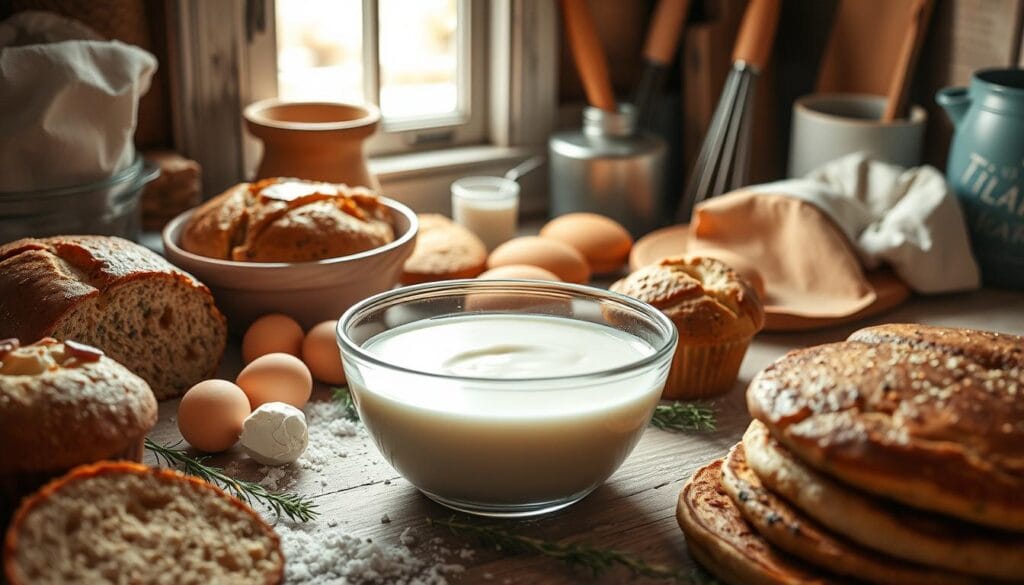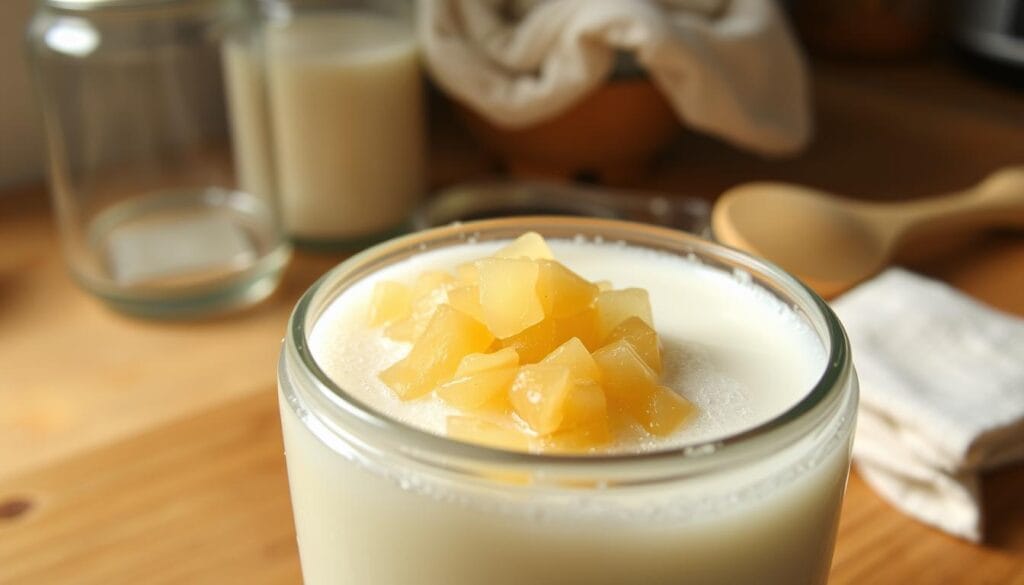
Ever wondered about a secret ingredient that could make your baking amazing? Welcome to the world of kefir in baking. It’s a probiotic-rich ingredient that’s about to change your kitchen adventures.
The global kefir market is growing fast, heading towards $2.44 billion by 2027. Home bakers are finding out how amazing it is. Just one ingredient can add a tangy twist and incredible moisture to your baked goods.
Kefir is more than just another dairy product. It’s a game-changer in the kitchen. It brings complexity, nutrition, and magic to your baking. Whether you’re an experienced baker or just starting, kefir can help you make delicious treats.
Table of contents
Understanding Kefir in Baking: A Fermented Dairy Powerhouse
Kefir is a fermented drink with a rich history and great nutrition. It’s more than just milk, with probiotics, nutrients, and flavor. It can change how you cook and eat.

Kefir comes from the mountains between Russia and Georgia. Shepherds found it kept food fresh and was good for health. They used special kefir grains to start the fermentation.
Origins and Traditional Uses
Old cultures saw kefir as a healing food. Nomads used it to keep food fresh and for nutrition. The fermentation makes a tangy, bubbly drink with health perks.
The Science Behind Fermentation
- Kefir grains have many bacteria and yeast
- Fermentation takes 18-24 hours
- Microorganisms change milk’s sugars
- It makes a probiotic-rich, easy-to-digest drink
Nutritional Profile of Kefir
Kefir is packed with nutrients. A cup has what you need for good health:
| Nutrient | Amount per 268g |
|---|---|
| Protein | 10g |
| Fat | 2g |
| Calcium | 390mg |
| Carbohydrates | 12g |
Kefir can be made from different milks like sheep, cow, goat, and even water for non-dairy options.
“Kefir is more than a drink – it’s a world of nutrition and taste.” – Artisan Fermentation Expert
Interested in health, nutrition, or cooking? Kefir is a great start into fermented foods.
What Does Kefir in Baking Do?
Kefir adds magic to your baking, making ordinary recipes special. It’s not just for flavor. It’s a versatile ingredient that does more.
Chemical Reactions in Baked Goods
Kefir starts amazing chemical reactions in your baked goods. Its acidity works with baking soda, making things rise naturally. This means your treats can get lighter without extra leavening agents.
- Reduces need for additional chemical leaveners
- Breaks down complex flour proteins
- Enhances nutrient bioavailability
Texture and Moisture Benefits
Using kefir in baking makes your treats tender and moist. It adds moisture and softness that other ingredients can’t match.
“Kefir transforms baking from a simple task to a nutritional art form.” – Culinary Experts
| Baking Ingredient | Kefir Impact |
|---|---|
| Buttermilk | Direct substitution with enhanced probiotic benefits |
| Regular Milk | Adds tanginess and improved texture |
| Water | Provides moisture and nutritional boost |
Leavening Properties
Kefir’s fermentation gives baked goods a natural lift. The active cultures in kefir work with flour, making things rise and feel lighter.
- Contains 12 active probiotic strains
- Reduces lactose levels by 20-30%
- Supports digestive health while baking
Pro tip: For the best results, use room-temperature kefir. It keeps its probiotics and makes your baking even better.
Substituting Kefir in Baking for Common Baking Ingredients
Discovering new ways to replace traditional dairy ingredients can change your baking. If you’re wondering if you can use kefir instead of milk, the answer is yes! Kefir is a versatile and nutritious option for your baked goods.
Many home bakers are curious about using kefir in their recipes. Here are some key points to keep in mind:
- Can I use kefir instead of yogurt in baking? Absolutely!
- Can you replace buttermilk with kefir in baking? With some simple adjustments, you can.
“Kefir is not just a substitution – it’s an upgrade to your baking ingredients.” – Culinary Experts
Kefir’s unique properties make it a standout ingredient. It has up to 60 different cultures, adding more than just liquid to your recipes. Here are some tips for substituting:
- Use a 1:1 ratio when replacing milk
- Strain kefir for thicker consistency if needed
- Adjust baking soda slightly due to kefir’s higher acidity
Pro tip: Kefir’s tangy flavor works brilliantly in pancakes, biscuits, and cakes, providing both moisture and a subtle depth of taste.
Kefir also offers nutritional benefits. It has more probiotics than traditional dairy, making your baked goods not only tasty but also potentially healthier.
Temperature Considerations When Using Kefir in Baking
Baking with kefir needs careful attention to temperature. This helps keep its unique properties. Knowing how heat affects kefir helps you make tasty baked goods and keep its nutritional value.
Heat’s Impact on Probiotic Survival
Probiotics in kefir are sensitive to high heat. So, can you bake with kefir? Yes, but with some careful planning:
- Probiotics start to die at temperatures over 140°F (60°C)
- Lower baking temperatures keep more beneficial bacteria alive
- Slow heating prevents kefir from curdling
Optimal Baking Temperatures for Kefir
To avoid kefir curdling, follow these temperature tips:
- Try baking at temperatures between 325°F and 350°F (163°C to 177°C)
- Use kefir in recipes that bake quickly
- Add kefir after baking for the best probiotic benefits
Pro tip: Treat kefir like a delicate ingredient that needs gentle handling during baking.
Practical Baking Strategies
To get the most from kefir in your baking, try these tips:
- Mix kefir into batters just before baking
- Use room temperature kefir to avoid sudden temperature shock
- Try no-bake recipes to keep more probiotics
Understanding how heat affects kefir lets you make delicious baked goods. You can also keep more of its nutritional benefits.
Best Types of Kefir for Baking Applications
Exploring kefir for baking means understanding the differences between types. Kefir is not just liquid yogurt. It’s a fermented dairy product with its own unique traits.
Choosing the right kefir is key to baking success. Plain, unflavored kefir is usually the best choice. Whether Greek yogurt or kefir is better depends on your recipe and goals.
Milk Options for Kefir
There are several milk options for kefir:
- Whole cow’s milk (traditional and most recommended)
- Goat’s milk (provides unique flavor profile)
- Organic milk (enhances probiotic content)
- Low-fat milk (for lighter baked goods)
“Homemade kefir offers unparalleled control over ingredients and fermentation process.” – Fermentation Experts
Kefir is packed with up to 60 different bacterial strains. This makes it more probiotic-rich than standard yogurt. Its diversity is key to its baking benefits.
Kefir Nutritional Snapshot
| Nutrient | Amount per Cup |
|---|---|
| Calories | 100-110 |
| Protein | 10g |
| Calcium | 390mg |
| Probiotics | 60+ strains |
For the best baking results, pick fresh, plain kefir. Try different milks to find your ideal baking partner.
Essential Tips for Success with Kefir in Baking
Learning to use kefir in baking is all about knowing its special traits and how to handle it. Whether you’re an experienced baker or just starting out, these tips will show you how to get the most out of kefir.
Smart Storage Strategies
Keeping kefir in the right place is key to its quality and how well it works in baking. Here are some important tips for storing kefir:
- Put kefir in the fridge right after buying or making it
- Check if kefir has gone bad by looking for:
- A bad smell
- Strange color changes
- Too much separation or mold
- Use kefir within two weeks of making it
- Let refrigerated kefir come to room temperature before baking
Preparation and Measurement Guidelines
Thinking about making kefir from store-bought kefir? You have a few options. Store-bought kefir can be used as a starter culture, but the results might not be the same as using traditional kefir grains.
“The secret to great baking is understanding your ingredients” – Baking Experts
Here are some tips for measuring kefir for baking:
- Measure kefir just like you would milk or buttermilk
- Use 5 grams of kefir grains per cup of milk for homemade batches
- Ferment at room temperature (65-85°F) for 24-48 hours
- Strain grains after fermentation
By following these tips, your baked goods will get the best from kefir. This will help keep the flavor and texture just right.
Common Mistakes to Avoid When Using Kefir in Baking
Baking with kefir can be tricky. But knowing what to avoid can help you make tasty treats. It’s important to know what not to mix with kefir for success in the kitchen.
When using kefir in baking, some mistakes can ruin your results. Here are the main errors to watch out for:
- Avoid using metal utensils that can react negatively with kefir cultures
- Never overheat kefir, which can destroy probiotic benefits
- Steer clear of ultra-pasteurized milk for kefir preparation
“Understanding your ingredients is the first step to perfect baking” – Culinary Experts
To figure out if you killed your kefir, look out for these signs:
- Unusual yeasty smell
- Visible mold growth
- Significant color changes
- Extreme separation of liquid and solids
| Mistake | Potential Consequence |
|---|---|
| Overmixing kefir in batter | Compromised texture |
| Using contaminated equipment | Potential bacterial interference |
| Exposing kefir to extreme temperatures | Loss of probiotic cultures |
Pro tip: Always handle kefir with clean, non-metallic utensils and store properly to maintain its beneficial properties.
Health Benefits of Using Kefir in Baked Goods
Discovering kefir’s nutritional power can change your baking. Is kefir good for you? Yes! It adds amazing health benefits to your baked goods, making them tasty and nutritious.
Kefir’s health benefits go beyond regular dairy. Its special fermentation makes it a nutrient-rich ingredient for your baked treats.
Digestive Wellness through Probiotic Powerhouse
Kefir is packed with probiotic cultures that boost digestive health. Lifeway Kefir has over 12 live and active probiotic cultures. They help:
- Improve gut microbiome balance
- Reduce bloating
- Support immune system function
- Alleviate symptoms of irritable bowel syndrome
Nutritional Enhancements in Every Bite
Adding kefir to your baked goods brings big nutritional gains. A single serving packs:
| Nutrient | Amount per Serving |
|---|---|
| Calcium | 390mg |
| Protein | 10g |
| Vitamin D | 3.8mcg |
| Lactose Content | 99% Lactose-Free |
Pro tip: Using kefir instead of regular dairy boosts nutrition and makes baked goods easier to digest.
Kefir turns ordinary baking into a nutritional journey, bringing health benefits in every delicious bite.
Creative Recipe Ideas Featuring Kefir in Baking
Discover the amazing world of kefir recipes and how to use this probiotic-rich ingredient in your baking. Whether you’re an experienced baker or just starting out, kefir can help you make delicious treats.
- Overnight Oats Delight: Mix ½ cup oats with 1 cup kefir for a healthy breakfast. Add chia seeds to make it thicker and increase protein. This dish has 353 calories and 14g of protein.
- Probiotic Banana Bread: Replace regular liquids with kefir to make a moist and tangy maple banana bread. It’s full of nutrients.
- Refreshing Kefir Sorbet: Try Strawberry Shortcake or Peaches and Cream flavors with raw kefir, frozen fruit, and honey.
“Kefir transforms ordinary baking into an extraordinary culinary experience!” – Baking Enthuasiast
Using kefir in baking does more than add flavor. It also makes your baked goods healthier. Raw kefir is packed with:
- Calcium and vitamin D
- Active enzymes
- Beneficial probiotic bacteria
- Essential amino acids
- OMEGA-3 fatty acids
Pro tip: Use kefir instead of yogurt, sour cream, or buttermilk. It adds a tangy taste and improves texture. Use it in everything from mashed potatoes to salad dressings.
Storing and Preserving Kefir-Based Baked Goods
Keeping kefir baked goods fresh is key to their taste and texture. To store them right, follow some important tips. This will help keep them fresh for longer and better.
“Fresh baked goods are a delight, but smart storage keeps them perfect for days!” – Baking Experts
The shelf life of kefir baked goods depends on the type. Most will stay good for 3-5 days if stored right. Here are some tips for keeping them fresh:
- Use airtight containers to prevent moisture loss
- Refrigerate delicate kefir baked goods
- Wrap items individually to maintain freshness
- Consider freezing for extended preservation
Freezing can make kefir baked goods last longer. Quick breads, muffins, and scones freeze well. Here’s how to freeze them:
- Cool baked goods completely
- Wrap tightly in plastic wrap
- Place in freezer-safe containers
- Label with the date of freezing
- Consume within 2-3 months for best quality
Kefir baked goods might get moister over time. This is because of kefir’s special properties. To keep them tasting and feeling their best, eat them within the suggested time. Store them at the right temperature too.
Pro tip: Thaw frozen kefir baked goods at room temperature or in the fridge. This helps keep their original texture and flavor.
FAQ:
What happens if you bake kefir?
Baking kefir kills probiotics but adds tanginess, moisture, and fluffy texture.
How do you use kefir in baking?
Replace milk or buttermilk with kefir for moist, tender, and flavorful baked goods.
Can I replace milk with kefir in baking?
Yes! Use a 1:1 ratio to add tanginess and enhance texture in recipes.
Can I use kefir instead of yogurt in baking?
Yes, substitute kefir for yogurt 1:1. Strain it for thicker consistency if needed.
Conclusion
Exploring baking with kefir opens up new culinary possibilities. Kefir adds unique flavors and health benefits to baking. Your kitchen becomes a place of creativity, blending fermented goodness with classic baking.
Kefir can make your recipes healthier and more exciting. Even though heat might reduce some of its health benefits, kefir is packed with nutrients. It adds moisture, a tangy taste, and more protein to your baked goods.
A study in the Journal of Ethnic Foods shows kefir’s rich microbiological makeup. Using kefir in your baking is not just about making tasty treats. It’s also about understanding the role of fermented foods in nutrition.
Using kefir in baking is more than a trend. It’s a way to make traditional recipes healthier. Try kefir in your baking and see how it can change your recipes for the better.
